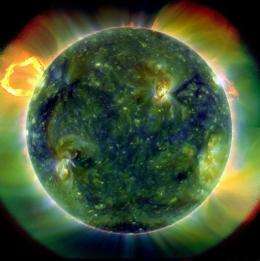Solar System older than thought

The Solar System could be nearly two million years older than thought, according to a study published on Sunday by the journal Nature Geoscience.
The evidence comes from a 1.49-kilo (3.2-pound) meteorite, found in the Moroccan desert in 2004, that contains a "relict" mineral, which is one of the oldest solid materials formed after the birth of the Sun.
Analysis of lead isotopes suggest the mineral was formed 4.45682 billion years ago, making the meteorite the oldest object ever found.
As a result, the Solar System is likely to be between 300,000 and 1.9 million years older than previous estimates, says the paper, authored by Audrey Bouvier and Meenakshi Wadhwa of Arizona State University's the Center for Meteorite Studies.
More information: Bouvier, A. & Wadhwa, M. Nature Geosci. advance online publication doi:10.1038/NGEO941 (2010).
(c) 2010 AFP

















